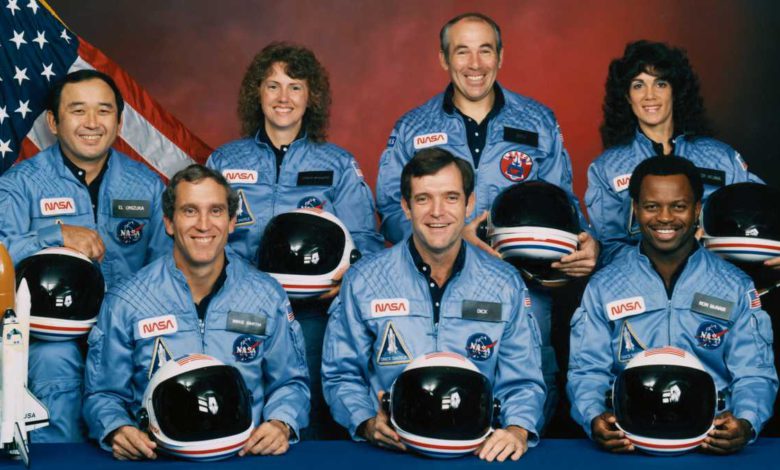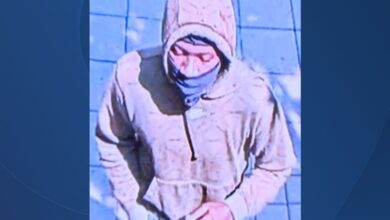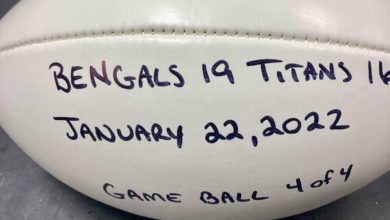
it is with deep, heartfelt sorrow. I address you here this afternoon at 11:40 a.m. This morning Space program experienced a national tragedy with the explosion of the space shuttle Challenger. Approximately a minute, half after launch from here at the Kennedy Space Center. Shouldn't. And it has cleared the tower. A challenger Good roll program confirmed. Yeah. Challenger now heading down range. I've made nine wonderful friends over the last two weeks. It's a great pleasure for us to be here. We expect weather like this on Sunday when we launch, and you all do the best to keep it that way. If you would. Engines throttling up three inches and 104% Challenger, go with throttle up. Dr. Door Drama, We've had negative conduct. Lost dealing fight. How can we get any reports from recovery forces? That's trouble of some kind. Okay, Que Everybody stay off the telephones at 73.191 seconds. Ah, flash was observed between the e. T and orbiter. That was immediately followed by the start of total vehicle break up at 73.213 seconds. It took two minutes and 45 seconds for the crew cabin to hit the water. The impact speed was 207 miles an hour. I regret that I have to report that based on very preliminary searches of the ocean where the challenger impacted this morning. These searches have not revealed any evidence that the crew of Challenger survived. Ah, puff of black smoke. It lift off was the ominous sign that Boselli was right. The O rings had already failed. The smoke appeared when they burned. After a few seconds, a jet of flame appeared. Ah, post accident report by NASA described it with passionless precision. The plume is seen here in pinching directly onto the surface of the external tank and the lower aft strut. At 60.248 seconds, the sideways flame burned like a welder's torch through the gap left by the blown O rings. It pierced the giant orange fuel tank, and fuel began streaming out. Still, no one knew anything was wrong. Not until Challenger, its astronauts and it's teacher in space, had flown for 73 seconds before the event from information that was available. Understanding it was fully appreciated everywhere that this deal would become unsatisfactory at some temperature. And was there some sort of a suggestion of a temperature at which I saw I saw be? I guess you call. It shouldn't be run. Yes, sir. There was a question of that to answer the first question. First, the data that was presented. It was the judgment that under the conditions that we would see on Launch Day, given the configuration that we ran, the CIA would function at that temperature. That was the final judgment at the bottom of the ocean. Investigators found that some of the crew's emergency oxygen masks had been turned on. Who died when you hit the water? You know that? Think so. That zero controversial. I don't know, sir, because of the controversial about No, it's hard evidence. Yeah, he died when you hit the water, challenges fast, launches fast, it's bang. And then it's a two minute ride down on your conscious. We know that we come together today to mourn the loss of seven brave Americans to share the grief that we all feel, and perhaps in that sharing to find the strength to bear our sorrow and the courage to look for the seeds of hope. our nation's loss is first, a profound personal loss to the family, the friends and the loved ones of our shuttle astronauts. The best we can do is remember our seven astronauts, our challenger seven remember them as they lived, bringing life and love and joy so those who knew them and pride to a nation. They came from all parts of this great country from South Carolina Toe Washington State, Ohio two Mohawk, New York, Hawaii to North Carolina to Concord, New Hampshire. They were so different. Yet in their mission, their quest, they held so much in common. The future is not free. The story of all human progress is one of a struggle against all odds. We learned again that this America, which Abraham Lincoln called the last best hope of man on Earth, was built on heroism and noble sacrifice. It was built by men and women, like our seven star Voyager's who answered a call beyond duty who gave more than was expected to required and who gave it a little thought of worldly reward. Today, the frontier is space on the boundaries of human knowledge. Sometimes when we reach for the stars, we fall short, but we must pick ourselves up again and press on. Despite the pain, our nation is indeed fortunate that we can still draw on immense reservoirs of courage, character and fortitude. But we're still blessed with heroes like those of the space shuttle Challenger, Dick, Mike, Judy, L. Ron, Greg and Christian. Your families and your country mourn your passing. We bid you goodbye way will never forget you. May God bless you all and give you comfort in this difficult time.
This day in history: It's been 36 years since the Space Shuttle Challenger disaster
Friday marks the 36th anniversary of the Challenger space shuttle explosion, a disaster that killed seven people 73 seconds after launch.An O-ring failure blamed on cold weather doomed the shuttle before it even left the launch pad.Just a few seconds into the mission, a flame was seen breaking through the solid rocket booster that would ultimately lead to the catastrophic explosion that claimed the lives of astronauts Dick Scobee, Michael Smith, Ronald McNair, Ellison Onizuka, Gregory Jarvis, Judith Resnick and teacher Christa McAuliffe. Their names were added to the Space Memorial Mirror at the NASA Kennedy Space Center.The incident resulted in a 32-month suspension of NASA's shuttle program and the creation of the Rogers Commission, a group created by Ronald Reagan to examine what went wrong.Here's a look at what you need to know about the 1986 space shuttle Challenger disaster. FactsSeven crew members died in the explosion, including Christa McAuliffe, who would have been the first teacher in space.The explosion was a result of a rocket booster failure which ignited the fuel tank.Some of the objectives of Mission STS-51L included the "Comet Halley Active Monitoring Program" (CHAMP), a fluid dynamics experiment and lesson plans and telecasts by Christa McAuliffe.TimelineApril 4, 1983 - The Challenger's maiden voyage, STS-6. The Challenger completed nine successful missions between 1983 and 1986.July 19, 1985 - New Hampshire teacher Christa McAuliffe is chosen to be the first teacher in space.Jan. 28, 1986 - The Space Shuttle Challenger explodes 73 seconds into flight at approximately 11:40 a.m. EST.Sept. 19, 2019 - The Christa McAuliffe Commemorative Coin Act of 2019 is passed by Congress. The act calls for the Department of Treasury to "issue not more than 350,000 $1 silver coins in commemoration of Christa McAuliffe." The act was signed by former President Donald Trump on Oct. 9, 2019. The coins were minted to commemorate the 35th anniversary of the tragedy.CrewFrancis R. (Dick) Scobee - Spacecraft Commander- Born - May 19, 1939- Birthplace - Cle Elum, Washington- Family - Wife, June, and two childrenMichael J. Smith - Pilot- Born on April 30, 1945- Birthplace - Beaufort, North CarolinaJudith A. Resnik - Mission Specialist- Born - April 5, 1949- Birthplace - Akron, OhioRonald E. McNair - Mission Specialist- Born - Oct. 21, 1950- Birthplace - Lake City, South Carolina- Family - Wife, Cheryl, and two childrenEllison S. Onizuka- Mission Specialist- Born - June 24, 1946- Birthplace - Kealakekua, Kona, HawaiiGregory B. Jarvis - Payload Specialist- Born - Aug. 24, 1944- Birthplace - Detroit, Michigan- An engineer who worked for Hughes Aircraft Corp.Christa McAuliffe- First teacher in space- Born - Sept. 2, 1948- Birthplace - Boston, MassachusettsWatch the video above to learn more about this story.
Friday marks the 36th anniversary of the Challenger space shuttle explosion, a disaster that killed seven people 73 seconds after launch.
An O-ring failure blamed on cold weather doomed the shuttle before it even left the launch pad.
Just a few seconds into the mission, a flame was seen breaking through the solid rocket booster that would ultimately lead to the catastrophic explosion that claimed the lives of astronauts Dick Scobee, Michael Smith, Ronald McNair, Ellison Onizuka, Gregory Jarvis, Judith Resnick and teacher Christa McAuliffe. Their names were added to the Space Memorial Mirror at the NASA Kennedy Space Center.
The incident resulted in a 32-month suspension of NASA's shuttle program and the creation of the Rogers Commission, a group created by Ronald Reagan to examine what went wrong.
Here's a look at what you need to know about the 1986 space shuttle Challenger disaster.
Facts
Seven crew members died in the explosion, including Christa McAuliffe, who would have been the first teacher in space.
The explosion was a result of a rocket booster failure which ignited the fuel tank.
Some of the objectives of Mission STS-51L included the "Comet Halley Active Monitoring Program" (CHAMP), a fluid dynamics experiment and lesson plans and telecasts by Christa McAuliffe.
Timeline
April 4, 1983 - The Challenger's maiden voyage, STS-6. The Challenger completed nine successful missions between 1983 and 1986.
July 19, 1985 - New Hampshire teacher Christa McAuliffe is chosen to be the first teacher in space.
Jan. 28, 1986 - The Space Shuttle Challenger explodes 73 seconds into flight at approximately 11:40 a.m. EST.
Sept. 19, 2019 - The Christa McAuliffe Commemorative Coin Act of 2019 is passed by Congress. The act calls for the Department of Treasury to "issue not more than 350,000 $1 silver coins in commemoration of Christa McAuliffe." The act was signed by former President Donald Trump on Oct. 9, 2019. The coins were minted to commemorate the 35th anniversary of the tragedy.
Crew
Francis R. (Dick) Scobee
- Spacecraft Commander
- Born - May 19, 1939
- Birthplace - Cle Elum, Washington
- Family - Wife, June, and two children
Michael J. Smith
- Pilot
- Born on April 30, 1945
- Birthplace - Beaufort, North Carolina
Judith A. Resnik
- Mission Specialist
- Born - April 5, 1949
- Birthplace - Akron, Ohio
Ronald E. McNair
- Mission Specialist
- Born - Oct. 21, 1950
- Birthplace - Lake City, South Carolina
- Family - Wife, Cheryl, and two children
Ellison S. Onizuka
- Mission Specialist
- Born - June 24, 1946
- Birthplace - Kealakekua, Kona, Hawaii
Gregory B. Jarvis
- Payload Specialist
- Born - Aug. 24, 1944
- Birthplace - Detroit, Michigan
- An engineer who worked for Hughes Aircraft Corp.
Christa McAuliffe
- First teacher in space
- Born - Sept. 2, 1948
- Birthplace - Boston, Massachusetts
Watch the video above to learn more about this story.
Source link









